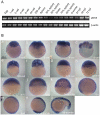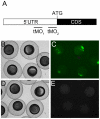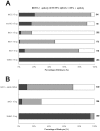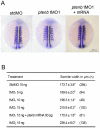Ptenb mediates gastrulation cell movements via Cdc42/AKT1 in zebrafish
- PMID: 21494560
- PMCID: PMC3073981
- DOI: 10.1371/journal.pone.0018702
Ptenb mediates gastrulation cell movements via Cdc42/AKT1 in zebrafish
Abstract
Phosphatidylinositol 3-kinase (PI3 kinase) mediates gastrulation cell migration in zebrafish via its regulation of PIP(2)/PIP(3) balance. Although PI3 kinase counter enzyme PTEN has also been reported to be essential for gastrulation, its role in zebrafish gastrulation has been controversial due to the lack of gastrulation defects in pten-null mutants. To clarify this issue, we knocked down a pten isoform, ptenb by using anti-sense morpholino oligos (MOs) in zebrafish embryos and found that ptenb MOs inhibit convergent extension by affecting cell motility and protrusion during gastrulation. The ptenb MO-induced convergence defect could be rescued by a PI3-kinase inhibitor, LY294002 and by overexpressing dominant negative Cdc42. Overexpression of human constitutively active akt1 showed similar convergent extension defects in zebrafish embryos. We also observed a clear enhancement of actin polymerization in ptenb morphants under cofocal microscopy and in actin polymerization assay. These results suggest that Ptenb by antagonizing PI3 kinase and its downstream Akt1 and Cdc42 to regulate actin polymerization that is critical for proper cell motility and migration control during gastrulation in zebrafish.
Conflict of interest statement
Figures











Similar articles
-
Wnt5b integrates Fak1a to mediate gastrulation cell movements via Rac1 and Cdc42.Open Biol. 2020 Feb;10(2):190273. doi: 10.1098/rsob.190273. Epub 2020 Feb 26. Open Biol. 2020. PMID: 32097584 Free PMC article.
-
Ptena and ptenb genes play distinct roles in zebrafish embryogenesis.Dev Dyn. 2005 Dec;234(4):911-21. doi: 10.1002/dvdy.20576. Dev Dyn. 2005. PMID: 16193492 Free PMC article.
-
Role of lbx2 in the noncanonical Wnt signaling pathway for convergence and extension movements and hypaxial myogenesis in zebrafish.Biochim Biophys Acta. 2012 May;1823(5):1024-32. doi: 10.1016/j.bbamcr.2012.02.013. Epub 2012 Mar 3. Biochim Biophys Acta. 2012. PMID: 22406073
-
Diaphanous-related formin 2 and profilin I are required for gastrulation cell movements.PLoS One. 2008;3(10):e3439. doi: 10.1371/journal.pone.0003439. Epub 2008 Oct 21. PLoS One. 2008. PMID: 18941507 Free PMC article.
-
Lpp is involved in Wnt/PCP signaling and acts together with Scrib to mediate convergence and extension movements during zebrafish gastrulation.Dev Biol. 2008 Aug 1;320(1):267-77. doi: 10.1016/j.ydbio.2008.05.529. Epub 2008 May 20. Dev Biol. 2008. PMID: 18582857
Cited by
-
Cdc42 controls primary mesenchyme cell morphogenesis in the sea urchin embryo.Dev Biol. 2018 May 15;437(2):140-151. doi: 10.1016/j.ydbio.2018.03.015. Epub 2018 Mar 16. Dev Biol. 2018. PMID: 29555242 Free PMC article.
-
Rho GTPases Signaling in Zebrafish Development and Disease.Cells. 2020 Dec 8;9(12):2634. doi: 10.3390/cells9122634. Cells. 2020. PMID: 33302361 Free PMC article. Review.
-
Zebrafish rgs4 is essential for motility and axonogenesis mediated by Akt signaling.Cell Mol Life Sci. 2013 Mar;70(5):935-50. doi: 10.1007/s00018-012-1178-z. Epub 2012 Oct 11. Cell Mol Life Sci. 2013. PMID: 23052218 Free PMC article.
-
Wnt5b integrates Fak1a to mediate gastrulation cell movements via Rac1 and Cdc42.Open Biol. 2020 Feb;10(2):190273. doi: 10.1098/rsob.190273. Epub 2020 Feb 26. Open Biol. 2020. PMID: 32097584 Free PMC article.
-
A GAL4-inducible transgenic tool kit for the in vivo modulation of Rho GTPase activity in zebrafish.Dev Dyn. 2016 Aug;245(8):844-53. doi: 10.1002/dvdy.24412. Epub 2016 May 17. Dev Dyn. 2016. PMID: 27105927 Free PMC article.
References
-
- Keller R. Shaping the vertebrate body plan by polarized embryonic cell movements. Science. 2002;298:1950–1954. - PubMed
-
- Solnica-Krezel L, Cooper MS. Cellular and genetic mechanisms of convergence and extension. Results Probl Cell Differ. 2002;40:136–165. - PubMed
-
- Schier AF. Axis formation and patterning in zebrafish. Curr Opin Genet Dev. 2001;11:393–404. - PubMed
-
- Warga RM, Kimmel CB. Cell movements during epiboly and gastrulation in zebrafish. Development. 1990;108:569–580. - PubMed
-
- Solnica-Krezel L. Conserved patterns of cell movements during vertebrate gastrulation. Curr Biol. 2005;15:R213–228. - PubMed
Publication types
MeSH terms
Substances
LinkOut - more resources
Full Text Sources
Molecular Biology Databases
Research Materials
Miscellaneous

